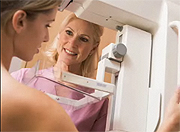
WEDNESDAY, July 20 (HealthDay News) — The value of annual mammograms for women in their 40s — the topic of a lingering debate among health policy and advocacy groups — has drawn resounding support from the nation’s largest group of obstetricians/gynecologists.
On Wednesday, the American College of Obstetricians and Gynecologists (ACOG) issued new guidelines calling for mammograms to be done every year beginning at age 40. This is a departure from its previous recommendations, which advised mammograms every one to two years beginning at 40 and then annually beginning at age 50, based on the incidence of breast cancer in younger women and its typically more rapid progression, guidelines co-author Dr. Jennifer Griffin explained.
The guidelines conflict with those issued in late 2009 by the U.S. Preventive Services Task Force, which recommended screening mammograms only every other year beginning at age 50 because they can result in many false positive results, prompting unnecessary biopsies and additional tests.
“I think the main point we considered was that about 40,000 women every year in their 40s are diagnosed with breast cancer, and about 20 percent of them will die from it,” said Griffin, an assistant professor of OB/GYN at the University of Nebraska Medical Center. “Screening mammograms reduce the risk of dying by 15 percent” in this population.
More than 207,000 American women were diagnosed with invasive breast cancer in 2010, according to ACOG, and nearly 40,000 died from it. Breast cancer is the second most common type of cancer among women in the United States after skin cancer. It may be detected by a mammogram while it is very small and before it grows big enough to become symptomatic.
A key factor in the ACOG recommendation is the shorter “sojourn time” — the time period in which a breast cancer can be detected by a mammogram while it is still very small and before it gets big enough to cause symptoms — among younger women. Women aged 40 to 49 have a sojourn time of 2 to 2.4 years, the guidelines said, while those ages 50 to 59 have a sojourn time of 2.5 to 3.7 years, and women 70 to 74 have a sojourn time of 4 – 4.1 years.
“In these younger patients, we have a smaller window because these cancers tend to grow faster, sooner,” said Dr. Lauren Cassell, chief of breast surgery at Lenox Hill Hospital in New York City. “There are plenty of patients who develop breast cancer between 40 and 50. The fear was we would miss these patients and see them at later stages.”
The American Cancer Society and the National Comprehensive Cancer Network’s screening recommendations are identical to ACOG’s new guidelines, while the National Cancer Institute calls for mammograms every one to two years beginning at age 40. In addition to concerns about fear-inducing false positive results, some officials have expressed concerns about radiation emitted from mammography machines, which typically equals that of a round-trip transcontinental airline flight.
“Mammograms are stressful to patients because some require follow-up,” Cassell said. “But unfortunately, to find the patients [with cancer], some are going to have false positives… At some level, I feel we have to accept that.”
Some early, noninvasive breast cancers, known as ductal carcinoma in situ (DCIS), never progress to dangerous cases, Griffin acknowledged, and mammogram detection may provoke aggressive treatment that ultimately is unnecessary or harmful.
But, “there’s not a lot of consensus exactly how many cancers might regress . . . and no way of knowing which ones might regress or progress,” she said. “It’s true that some of these cancers we detect would not progress.”
The potential cost of mammograms was not taken into account in making the recommendations, Griffin added, but that was also true of the 2009 U.S. Preventive Services Task Force guidelines. Overall, about 1,900 women aged 39 to 49 would need to be “invited for screening” (though some might decline) to save one woman in that age range from dying of breast cancer, the ACOG said.
“This is all based on our best judgment with the best available evidence,” Griffin said. “Women in their 40s typically have children, some have elderly parents, many are active in the workforce. I don’t think we can really underestimate the value of that one life saved.”
The American College of Radiology (ACR) and Society of Breast Imaging said they supported the updated ACOG recommendations, noting that National Cancer Institute data show the U.S. breast cancer death rate — previously unchanged for 50 years — has dropped 37 percent since mammograms became widespread in 1990.
“I think not screening these patients yearly is taking a step backward,” said Dr. Donna Plecha, division chief of breast imaging at University Hospital’s Case Medical Center in Cleveland. “The cure rate in the early stages of breast cancer is in the high 90s [percent]. So I think it’s prudent for patients in that age group to come in yearly.”
More information
For more about young women and breast cancer, visit the Cleveland Clinic.

